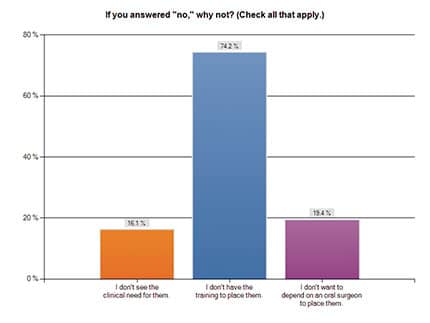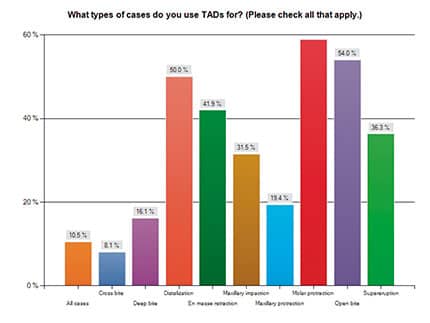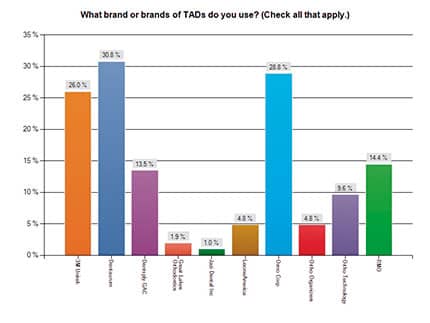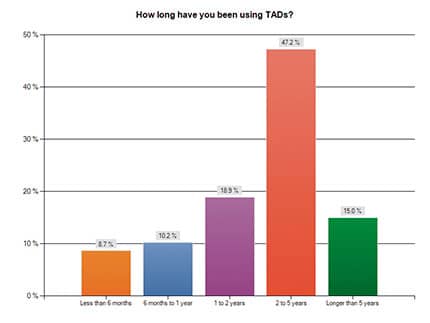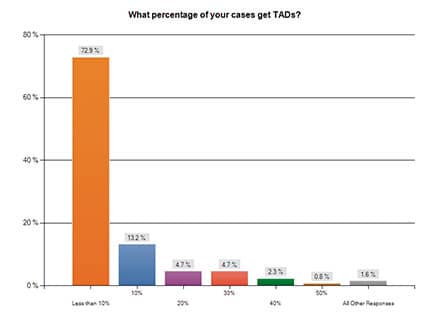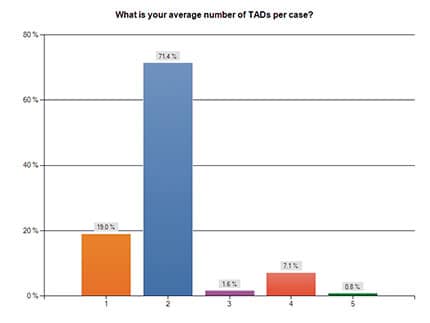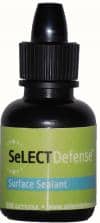How and how often do orthodontists use temporary anchorage devices?
By Christopher Piehler
Every issue of this magazine presents readers with new, ever-advancing products, but how many orthodontists actually use anything beyond basic brackets and wires in their practices? To find out, Orthodontic Products has launched a series of reader surveys that will continue throughout the year.
The goal of our fourth survey was to discover if and how our readers use TADs. To gather our data, we sent an e-mail survey to our subscribers, with the incentive of a $50 gift card for filling it out. We received a total of 148 responses.
In the accompanying charts, each answer is labeled with the percentage of respondents who gave that answer. Here’s what they had to say.
Do you use TADs?
With 80.4% of respondents answering in the affirmative and another 8.1% adding that they plan to start using TADs within the next year, it’s fair to say that whether you call them miniscrews, MSIs, TSADs, or TADs, nearly all orthodontists have seen their benefits and are taking advantage of them. While TADs are approaching universal acceptance, 11.5% of our respondents said that they do not use them and do not plan to.
s
If you answered “no,” why not? (Check all that apply.)
Among the naysayers, by far the biggest obstacle to using TADs in their practice was a lack of training (74.2%). Another 16.1% of our TAD-eschewing readers declared that they saw no clinical need for the devices, and 19.4% also preferred not to depend on an oral surgeon to place temporary anchorage for them.
If you do use TADs, do you place them yourself or does a surgeon place them?
Speaking of oral surgeons, 35.4% of our respondents delegate the placement of TADs to their colleagues. Nearly twice as many orthodontists, though, replied that they have gotten the necessary training to place their own TADs. With associations and companies offering ample TAD-related CE, this number should grow in the coming years.
What types of cases do you use TADs for? (Please check all that apply.)
We offered our survey-takers lots of options on this question, and they gave us lots of different answers. The top three most popular uses for TADs were molar protraction (58.9%), open bite (54.0%), and distalization (50.0%). A small but significant 10.5% of our respondents said that they have used TADs for all types of cases. This brings up a follow-up question: are there now or will there soon be TAD-only practices?
What brand or brands of TADs do you use? (Check all that apply.)
Another sign of the ubiquity of TADs is that, where there were only a handful of brands a few years ago, there is now an abundance of options for orthodontists to choose from. Among our cohort, the three most-mentioned brands were Dentaurum (30.8%), Ormco (28.8%), and 3M Unitek (26.0%). We also offered “Other (please specify)” as a possible answer to this question, and the brands that did not make the chart but got at least one mention included ACE Surgical, American Orthodontics, Dentos, Forestadent, G&H Wire, KLS Martin, Lancer, and Masel.
How long have you been ?using TADs?
A strong plurality (47.2%) of our readers have been using TADs for 2 to 5 years. On the early adopter side, 15.0% of those who took our survey said that they have been employing temporary anchorage for more than 5 years. The veterans were outnumbered by the newbies: 18.9% of our respondents reported that they have started using TADs within the past year.
What percentage of your cases get TADs?
While most orthodontists seem to be using TADs, they also seem to be using them sparingly. A whopping 72.9% of our orthodontic group said that they bring out the TADs for less than 10% of their cases. On the other side of the coin, only a tiny 1.6% of our respondents estimated that they use TADs in more than half of their cases.
What is your average number of TADs per case?
This was another landslide. By far the most common number of TADs was two per case (71.4%). Using one TAD to treat a patient came in a distant second at 19.0%.
Based on all of these answers, we can begin to sketch a portrait of the typical TAD user: he started placing his own TADs a few years ago, and most commonly uses two miniscrews to protract molars. While the ability to treat TAD cases without the help of a surgeon appears to be common, these cases still make up a small minority of what orthodontists do in their clinics every day.


